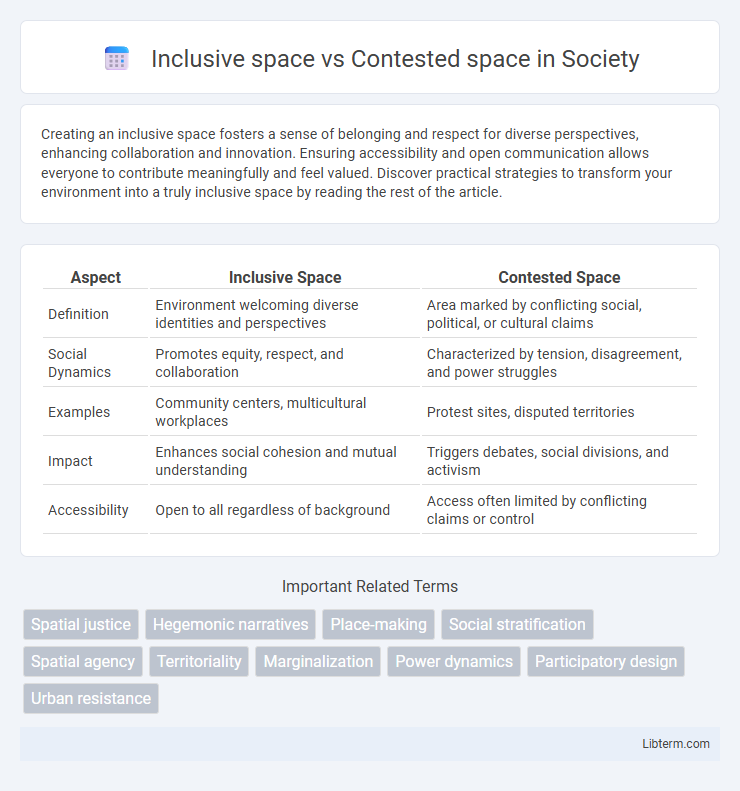Creating an inclusive space fosters a sense of belonging and respect for diverse perspectives, enhancing collaboration and innovation. Ensuring accessibility and open communication allows everyone to contribute meaningfully and feel valued. Discover practical strategies to transform your environment into a truly inclusive space by reading the rest of the article.
Table of Comparison
| Aspect | Inclusive Space | Contested Space |
|---|---|---|
| Definition | Environment welcoming diverse identities and perspectives | Area marked by conflicting social, political, or cultural claims |
| Social Dynamics | Promotes equity, respect, and collaboration | Characterized by tension, disagreement, and power struggles |
| Examples | Community centers, multicultural workplaces | Protest sites, disputed territories |
| Impact | Enhances social cohesion and mutual understanding | Triggers debates, social divisions, and activism |
| Accessibility | Open to all regardless of background | Access often limited by conflicting claims or control |
Defining Inclusive Spaces: Key Characteristics
Inclusive spaces prioritize accessibility, equity, and active participation from diverse groups, ensuring all voices are valued and respected. Key characteristics include physical and social accessibility, cultural sensitivity, and fostering a sense of belonging and safety. These spaces promote collaboration and shared decision-making, reducing barriers linked to identity, ability, or background.
Understanding Contested Spaces: Core Concepts
Contested spaces are characterized by conflicting claims and struggles over physical or symbolic territories, often reflecting deep-rooted social, political, or cultural tensions. These spaces embody power dynamics where multiple groups vie for recognition, control, or legitimacy, resulting in ongoing disputes and negotiations. Understanding contested spaces requires analyzing the historical context, stakeholder narratives, and the mechanisms through which space is produced, maintained, and transformed.
Historical Evolution of Space Inclusion and Contestation
Inclusive spaces have historically evolved through social movements advocating for equal access and representation, transforming public areas into sites of multicultural interaction and shared rights. Contested spaces emerge when conflicting groups assert dominance or resist inclusion, reflecting power struggles tied to race, class, and political ideology. Urban development and legal reforms often mediate this dynamic, reshaping spatial boundaries and access over time.
Societal Impacts of Inclusive Spaces
Inclusive spaces foster social cohesion by promoting diversity and equal participation, leading to reduced discrimination and heightened community well-being. These environments encourage collaboration and mutual respect, which enhance mental health and economic opportunities for marginalized groups. The societal impacts of inclusive spaces also include fostering innovation and resilience by integrating diverse perspectives into decision-making processes.
Drivers of Contested Spaces in Modern Societies
Drivers of contested spaces in modern societies include political polarization, social inequality, and cultural conflicts, which challenge the creation of inclusive environments. Economic disparities exacerbate tensions over access to resources, while identity-based struggles fuel disputes over public representation and participation. Urbanization and globalization further intensify these conflicts by reshaping social dynamics and spatial arrangements.
Inclusive Space Design: Principles and Examples
Inclusive space design emphasizes accessibility, diversity, and equity, ensuring environments cater to people of all abilities, backgrounds, and identities. Key principles include universal design, flexible layouts, clear signage, and culturally diverse elements that promote comfort and belonging. Examples range from community parks with wheelchair-accessible features to coworking spaces designed with gender-neutral restrooms and quiet zones for neurodiverse users.
Power Dynamics and Negotiation in Contested Spaces
Contested spaces reveal complex power dynamics where multiple groups negotiate control, access, and meaning, often leading to conflict and resistance. These areas become arenas for asserting dominance or demanding recognition, reflecting broader social, political, and cultural tensions. Negotiation in contested spaces involves continuous struggle over legitimacy, identity, and resources, highlighting the fluid and contested nature of spatial authority.
The Role of Policy in Shaping Inclusive and Contested Spaces
Policy plays a crucial role in shaping spaces by defining access, rights, and resource allocation, which can foster inclusivity or incite contention. Inclusive spaces emerge when policies promote equity, diversity, and participation, ensuring marginalized groups have representation and voice. Conversely, contested spaces often arise from exclusionary or discriminatory policies that marginalize certain communities, leading to social conflict and resistance.
Case Studies: Transforming Contested Spaces into Inclusive Places
Case studies such as the transformation of Belfast's Peace Walls and Johannesburg's inner-city redevelopment demonstrate effective strategies for converting contested spaces into inclusive places that promote social cohesion and cultural integration. These initiatives often involve community engagement, shared public art, and participatory urban design to dismantle physical and symbolic barriers. Metrics of success include increased cross-group interaction, reduced conflict incidents, and enhanced sense of belonging among historically marginalized populations.
Future Directions: Fostering Spatial Inclusivity in Diverse Communities
Future directions for fostering spatial inclusivity emphasize designing urban environments that prioritize equitable access and representation for marginalized groups. Integrating community-led planning and adaptive public policies can transform contested spaces into inclusive areas that reflect diverse cultural identities and social needs. Technology-driven mapping and participatory design tools empower communities to reclaim and reshape spaces, promoting long-term social cohesion and spatial justice.
Inclusive space Infographic

 libterm.com
libterm.com